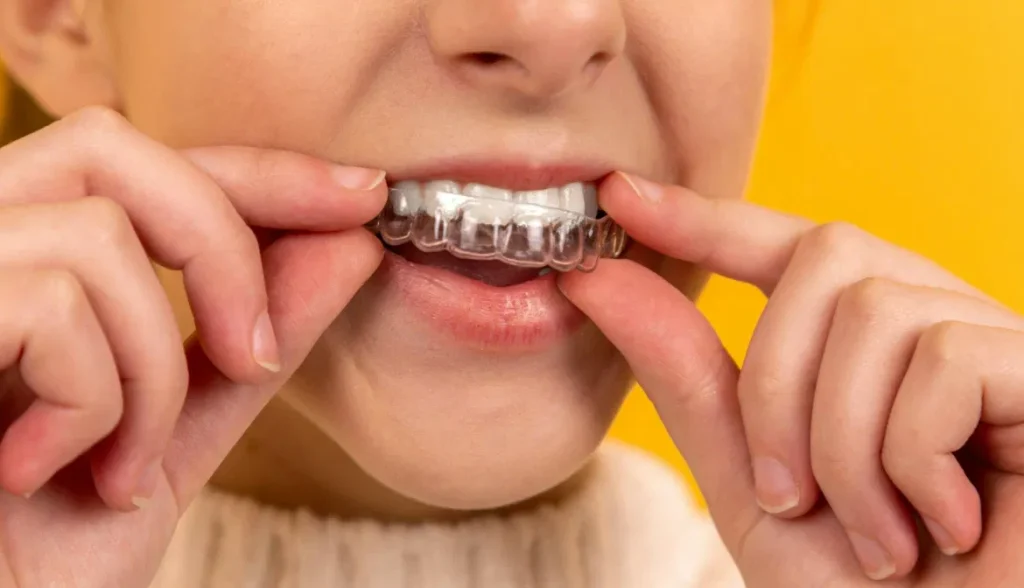Beyond the CPAP
If you or a loved one has been diagnosed with Obstructive Sleep Apnea (OSA), you know the struggle. The constant fatigue, the loud snoring, the concern for your long-term health. For decades, the Continuous Positive Airway Pressure (CPAP) machine has been the gold-standard treatment. But let’s be honest: for many, CPAP is bulky, noisy, and uncomfortable.
The good news? The world of sleep medicine has evolved. Sleep apnea mouthpieces, also known as oral appliances, have emerged as a powerful, comfortable, and highly effective alternative for millions. No longer a niche solution, modern oral appliances are FDA-cleared, professionally fitted, and technologically advanced.
This guide will cut through the noise. We’ll explore how these devices work, the different types available, who they are best for, and how to navigate the process of getting one in 2025 and beyond. Consider this your one-stop resource for taking back your sleep.
What is a Sleep Apnea Mouthpiece and How Does It Work?
A sleep apnea mouthpiece is a dental-grade oral appliance worn during sleep. It’s designed to prevent the airway collapse that causes obstructive sleep apnea and snoring.
Obstructive Sleep Apnea occurs when the muscles in the back of your throat relax too much during sleep. This causes your tongue and soft palate to collapse against the back of your throat, blocking your airway.
A mouthpiece counteracts this in two primary ways:
- Mandibular Advancement: The most common type, a Mandibular Advancement Device (MAD), gently holds your lower jaw (mandible) forward. This mechanical action tightens the soft tissues and muscles of the upper airway, preventing them from collapsing and obstructing breathing.
- Tongue Retention: A Tongue Stabilizing Device (TSD) uses gentle suction to hold the tongue forward, preventing it from falling back and blocking the throat.
Think of it as a mechanical solution to a mechanical problem. By creating more space in the airway, air can flow freely, reducing or eliminating apneas (breathing pauses) and hypopneas (shallow breathing).
Types of Sleep Apnea Mouthpieces
Not all mouthpieces are created equal. Understanding the categories is key to finding your perfect match.
1. Mandibular Advancement Devices (MADs)
MADs are the most prescribed type of oral appliance. They consist of two trays (like athletic mouthguards) that fit over your upper and lower teeth. They are connected by a mechanism that allows the lower jaw to be advanced incrementally.
- Boil-and-Bite (Over-the-Counter): These are semi-customizable devices you fit yourself at home by softening them in hot water. They are a budget-friendly option for primary snoring or very mild OSA but are not recommended for moderate to severe apnea due to potential for improper fit, jaw pain, and tooth movement.
- Custom-Fit by a Dentist: The gold standard for efficacy and safety. A dentist or orthodontist takes precise digital impressions of your teeth to create a device that is unique to your mouth. This ensures optimal comfort, effectiveness, and minimizes side effects. This is the option we strongly recommend for treating diagnosed sleep apnea.
2. Tongue Stabilizing Devices (TSDs)
TSDs are a great alternative for people who may not be candidates for a MAD, such as those with poor dental health, no teeth, or a very strong gag reflex. They are a single-piece device that you press your tongue into, creating a seal that holds it forward.
Who are they for?
- Individuals who primarily have tongue-based airway obstruction.
- Those with dentures or significant dental work.
- People who cannot tolerate jaw advancement.
Are You a Candidate for a Sleep Apnea Mouthpiece?
Oral appliances are not for everyone. The best way to determine candidacy is through a formal sleep study and a consultation with a sleep specialist and a qualified dentist.
You are likely a GOOD candidate if you:
- Have been diagnosed with mild to moderate Obstructive Sleep Apnea.
- Have severe OSA but cannot tolerate or comply with CPAP therapy.
- Are a positional sleeper (apnea occurs mainly on your back).
- Seek a quiet, portable, and travel-friendly solution.
- Have a healthy jaw joint (TMJ) and good dental health.
You may NOT be a good candidate if you:
- Have central or complex sleep apnea (a neurological issue, not physical).
- Have severe temporomandibular joint (TMJ) disorders or significant jaw pain.
- Have poor dental health, insufficient teeth, or advanced gum disease.
- Have limited jaw mobility or a very small jaw.
Sleeping Zones Pro-Tip: A collaborative approach between your sleep physician and a dentist trained in dental sleep medicine is crucial for success. Your physician diagnoses the problem, and the dentist provides the solution tailored to you.
The 2025 Process: How to Get Your Mouthpiece
Gone are the days of one-size-fits-all. Here’s the modern, professional pathway:
- Get a Formal Diagnosis: You must have a sleep study (in-lab or at-home) to confirm OSA and its severity. Self-diagnosing and self-treating sleep apnea is dangerous.
- Consult Your Sleep Physician: Discuss your interest in an oral appliance. They will determine if it’s a medically appropriate option for you and provide a written prescription.
- Find a Qualified Dental Sleep Practitioner: Look for a dentist with credentials from organizations like the American Academy of Dental Sleep Medicine (AADSM). They have the specific training required.
- Digital Scanning & Fitting: The dentist will use an intraoral scanner (no more messy putty impressions!) to create a perfect 3D digital model of your teeth. This model is sent to a lab to fabricate your custom device.
- Delivery & Titration: When your device arrives, you’ll have a fitting appointment. The dentist will show you how to insert, remove, and clean it. They will also begin the process of “titration” – making small, incremental adjustments to advance your jaw to the most therapeutic and comfortable position.
- Follow-Up & Compliance Monitoring: This is what sets 2025 apart. Many modern devices now integrate with apps (e.g., SomnoMed’s SomnoCheck) or have built-in sensors that track your nightly usage and effectiveness. This data is shared with your doctor and dentist to ensure optimal therapy, a feature once exclusive to CPAP.
Top Considerations for 2025 & Beyond
The field is advancing rapidly. Here’s what to look for in a modern device:
- Micro-Adjustability: The best MADs allow for tiny, precise advancements (sometimes as small as 0.1mm) for perfect calibration.
- Vertical Opening: Newer designs focus on allowing a more natural bite and minimizing jaw strain by controlling how much the mouth is held open.
- Hybrid Devices: The line between CPAP and oral appliances is blurring. Devices like the Sunrise combine a minimal, nasal-only CPAP mask with a mandibular advancement component, offering the benefits of both worlds.
- Material Science: Devices are now made from sophisticated, medical-grade polymers that are durable, hypoallergenic, and designed for long-term comfort.
- Telehealth Integration: Follow-up appointments and titration checks are increasingly handled via virtual consultations, making care more accessible.
Potential Side Effects and How to Mitigate Them
With a professionally fitted device, side effects are usually minor and temporary. They can include:
- Jaw muscle tenderness or morning soreness
- Temporary changes in bite
- Excessive salivation or dry mouth
- Tooth discomfort
Mitigation is key: A gradual titration schedule, performed by your dentist, allows your muscles and joints to adapt. Regular dental check-ups (every 6 months) are essential to monitor your oral health and the fit of the device.
Conclusion: Your Path to Quieter Nights and Brighter Mornings
A sleep apnea mouthpiece is no longer just a simple snoring solution. It is a sophisticated, clinically-proven medical device that represents freedom for countless individuals who struggle with CPAP.
If you’re tired of being tired and are looking for a modern, effective, and comfortable way to treat your sleep apnea, a custom-fitted oral appliance could be the answer you’ve been searching for.
Your next step is clear: Talk to your doctor about a sleep test and ask if an oral appliance is right for you. Then, partner with a qualified dental sleep expert to begin your journey to restorative sleep.
Frequently Asked Questions (FAQ)
Q: How much does a custom sleep apnea mouthpiece cost?
A: In 2025, a custom-fitted MAD typically ranges from $1,800 to $3,500. This usually includes the appliance, all dental visits, fittings, and follow-up adjustments. While it’s an investment, many medical insurance plans (including Medicare) now cover them when prescribed for OSA. Always check with your provider.
Q: Are over-the-counter boil-and-bite devices effective for sleep apnea?
A: For diagnosed sleep apnea, no. They are only FDA-cleared for snoring. They lack the precision of a custom device, often leading to poor efficacy, jaw problems, and tooth damage. Investing in a professional solution is investing in your health.
Q: How long does a mouthpiece last?
A: With proper care, a high-quality custom device typically lasts 3-5 years. Over time, the material can wear, and your dental structure can change, necessitating a replacement.
Q: Can I use a mouthpiece if I have dentures?
A: It depends. A traditional MAD requires natural teeth to anchor onto. However, a Tongue Stabilizing Device (TSD) is an excellent option for denture wearers, as it doesn’t rely on teeth for retention.
Q: How do I clean my oral appliance?
A: Daily cleaning is simple. Gently brush it with a soft toothbrush and antibacterial soap or a non-abrasive toothpaste. Weekly, you can use a denture cleaning tablet. Avoid hot water, as it can warp the material.


